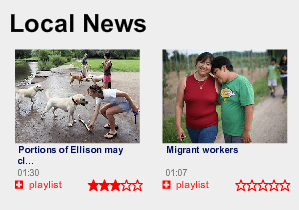 Listen up, local television stations. Remember the monopoly you used to have on video? It’s long gone. More than 1,000 U.S. newspapers now have video online, and some of it isn’t bad. “The possibility to replace television is in sight,” washingtonpost.com’s Travis Fox recently told New York Magazine. Is it time for TV to worry?
Listen up, local television stations. Remember the monopoly you used to have on video? It’s long gone. More than 1,000 U.S. newspapers now have video online, and some of it isn’t bad. “The possibility to replace television is in sight,” washingtonpost.com’s Travis Fox recently told New York Magazine. Is it time for TV to worry?
Consider that the No. 1 local Web site in almost every major market is run by a newspaper. “I doubt if most people could name the lead TV station in their hometown,” Houston Chronicle Editor Jeff Cohen told a journalism conference in St. Louis earlier this year. “I don’t care how much money they spend; no competitor or aggregator is going to get around our dominance at home.”
Now consider how aggressive newspaper companies have been about learning TV’s stock-in-trade. Over the past two years, Gannett has trained 500 print photographers to shoot video. The San Jose Mercury News has equipped its entire photography staff with high definition video cameras. About a dozen newspapers sent staffers to this year’s National Press Photographers Association NewsVideo workshop, where one of them–the Houston Chronicle’s Meg Loucks–won the best video shooter award.
Worried yet? There’s more. Hearst will launch ad-supported video channels on its papers’ Web sites later this year. Other newspaper companies already are producing their own online newscasts. Add it all up, and television news executives could be forgiven for thinking that the apocalypse is upon them.
But wait. Take a closer look at the competition.
California’s Ventura County Star, owned by E.W. Scripps, got into the Webcast act a few months ago with Studio805, a two-minute headline package presented by a young staff reporter. “We have no intention of trying to match television newscasts,” Managing Editor John Moore told readers. “We’re not going to give you live coverage via helicopter of the latest car chase, or have someone stand at the scene of the crime 10 hours after it happened to pretend like it’s live news.” Fair enough, but the Star apparently doesn’t intend to match what’s good about TV news, either. Studio805 uses little video, and the still photos that illustrate stories pop up almost at random, without explanation. [June 2008 update: the Webcast is no longer being produced; Studio805 is now a collection of video features.]
Another Scripps paper, Florida’s Naples Daily News, has had more time to perfect its vodcast; Studio55 debuted a year ago (see “Adapt or Die,” AJR, June/July 2006). The 15-minute program “airs” twice daily on the Web and a local cable outlet. The paper calls it groundbreaking and innovative, a source of hyperlocal news for a community underserved by the closest TV stations some 35 miles away. But the production is amateurish at best, and there’s nothing distinctive about the content. Studio55 offers garden-variety local news, sports and weather over an annoying music track. Some of the rotating hosts are better than others, but none is ready for prime time. One recently stumbled through a story about “a silver of land.”
A few newspapers are doing more distinctive work online. The Roanoke Times and Norfolk’s Virginian-Pilot, two Virginia papers owned by Landmark, produce chatty, informal Webcasts clearly designed for online users, with verbal and visual reminders to “hit that link” for more information. Roanoke calls its TimesCast “the anti-TV.”
Should television newsrooms feel insulted by the way newspapers describe their online video ventures? Not at all, says News Director Stacy Owen of KXTV, the Gannett-owned station in Sacramento. “I think they’re smart,” she says. Newspapers “think it’s in their best interest to differentiate themselves from a medium they don’t think serves people particularly well.” Owen believes television still has a leg up with online video “because people come to us for moving pictures,” but she says TV stations have to capitalize quickly on that advantage.
KXTV hopes to succeed online by trying something new. The station has turned former news anchor Sharon Ito into a Web-only anchor for News10.net. Unlike her online newspaper counterparts, Ito doesn’t read headlines. Instead, she moderates live chats with viewers, explains how the newsroom makes decisions, anchors breaking news and pursues stories of interest to the Web audience. Owen says Ito’s most important function is to be accessible. “Television has personalities people already know and have relationships with,” Owen says, “so why not develop that relationship in a new way?”
Another Gannett station, KARE-TV in Minneapolis, is seeking the same result with a slightly different approach. “A Web-based show with a television component” is how News Director Tom Lindner describes KARE OnLive, a half-hour daily “news hybrid” simulcast on TV and online at 4 p.m. Conceived as a conversation about the news, the program invites users to participate via Webcam. Lindner says TV stations have done a good job of making news available online when the audience wants it. “What we haven’t done as good a job at is bringing the personality that’s always been popular [on] television newscasts to the Web,” he says. “Hopefully, this is a way to bridge that.”
In the end, television’s ability to stay competitive online may not be about the video at all. “We have to play to our strength,” says Owen, “what sets us apart from newspapers. Our people.”
This article was originally published in American Journalism Review June/July 2007








